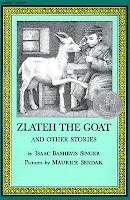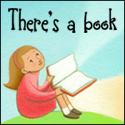1. Lemony Snicket and Lisa Brown. The Latke Who Couldn't Stop Screaming: A Christmas Story (McSweeney's, 2007). From one of our greatest contemporary Jewish children's writers, Lemony Snicket, aka Daniel Handler, and his wife, the witty illustrator Lisa Brown, comes this hilarious picture book about a latke who has had it up to here with trying to explain Hanukkah to all kinds of Christmas symbols, from candy canes to pine trees. He can't help screaming because Hanukkah is not a Jewish Christmas! Absolutely pitch perfect for American Jewish children who are deluged with Christmas symbols in December, and a great read-aloud--the kids will love to join in with the latke as he screams his way through the book!
2. Arthur Yorink and William Steig. The Flying Latke (Aladdin, 2002). Another hilarious read-aloud features a completely wacky story about a family gathering for Hanukkah--they all start arguing with each other and eventually fling a latke out the window, a latke which the government mistakes for a U.F.O.! Like Mo Willems' Knuffle Bunny, the artwork combines drawings (in this case by William Steig of Shrek fame) and photographs, many of which are of famous people in the children's book world such as Maurice Sendak and Vladimir Radunksy. Lots of Yiddish words give atmosphere to the story, which seems like something from an old Woody Allen movie. Unfortunately out of print, but you might find it used or at the library.
3. Eric Kimmel and Gloria Carmi. The Chanukkah Guest (Holiday House, 1992). A delightful comic story set in the Old Country, where Bubba Brayna is so old she's almost blind and deaf, but she still makes the best potato latkes in the village. On the first night of Hanukkah, she makes a special batch for the rabbi, but when she lets in her guest, she's in for a surprise. It turns out to be a hungry bear, but she can't tell the difference between the bear and the rabbi! It doesn't matter, because the bear enjoys the latkes...only what is Bubba to do when the rabbi finally arrives and no latkes are left?
4. Eric Kimmel and Trina Schart Hyman. Hershel and the Hanukkah Goblins (Holiday House, 1994). This Caldecott-honor title is a great read-aloud for the elementary school age crowd (it can be scary for very young children). Hershel of Ostropol, the famous trickster (an actual historical person, by the way) arrives at a tiny village on the first night of Hanukkah. The villagers are terrorized by wicked goblins, who don't allow any Hanukkah celebrations. Can Hershel outwit the King of the Goblins himself? Wonderful illustrations evoke the long-gone world of the Eastern European shtetl.
Hear Eric Kimmel read the story himself at this link.
5. Michael Rosen and Aminah Brenda Lynn Robinson. Elijah's Angel: A Story for Chanukah and Christmas (Harcourt, 1992). This moving story of religious tolerance centers on a young Jewish boy and his friendship with an elderly African-American barber, who carves wooden figures from the Bible. But when Michael is given a special carved angel as a gift, he is faced with a dilemma, because he knows Judaism forbids graven images. This story is based on the real-life folk artist Elijah Pierce (1892-1984), whose works can be seen at the Columbus Museum of Art, and features stunning illustrations in a broad-brush folk art style, which seem to have Elijah Pierce's radiant spirit shining through them.
6. Issac Bashevis Singer and Maurice Sendak. Zlateh the Goat and Other Stories (Harper Collins, 2001--originally published 1966). As far as I'm concerned, Issac Bashevis Singer's wonderful stories about the Polish town of Chelm belong on every child's bookshelf, Jewish or not. While not all the stories in this collection have to do with Hanukkah, the title story, Zlateh the Goat, is a Hanukkah tale, and makes an excellent read-aloud for older children. In this touching story, a family decides that they must sell their dairy goat in order to have money for Hanukkah and other necessities. Twelve-year old Aaron is charged with taking Zlateh to sell to the butcher, but on the way, a terrible snow storm hits. Zlateh's milk and warmth save the boy's life as they burrow into a haystack, and when they return the family cannot bear to be parted from her. Combine Singer's wonderful writing with Sendak's inimitable drawings and you have a true classic (and Newbery Honor book).
7. Maxie Baum and Julie Paschkis. I Have a Little Dreidel (Scholastic, 2006). Although this book was not available when my kids were the appropriate age, this would definitely be part of my rotation for preschool and early elementary aged children. This colorful oversized picture book features the familiar Hanukkah song, supplemented with additional verses depicting all the events of a typical family Hanukkah celebration with relatives arriving, latkes cooking, lighting the candles, eating supper, and finally playing dreidel. The author includes a recipe for latkes, rules on how to play the dreidel game, and the music for the dreidel song.
8. Eric Kimmel and Emily Lisker. A Hanukkah Treasury (Henry Holt, 1998). This anthology is a handsomely illustrated compilation of all sorts of Hanukkah goodies, from the story of the Maccabees, the menorah, and the dreidel to traditional songs and blessings, to folk tales about Hanukkah. In fact this one volume could provide more than enough stories for each of the eight nights, but why should you skimp on Hanukkah books?
For information on some Hanukkah books for children released in 2010, see this informative post by Linda Silver from the Greater Cleveland Chapter of the Association of Jewish Libraries.











































































